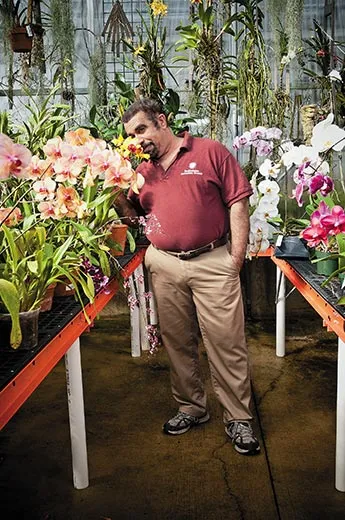Tom Mirenda on Orchids
The Natural History Museum’s orchid expert talks about the beloved flowers
/https://tf-cmsv2-smithsonianmag-media.s3.amazonaws.com/filer/ATM-QA-Tom-Mirenda-Smithsonian-gardens-631.jpg)
Tom Mirenda helps maintain the nearly 8,000 orchids in the Smithsonian’s collection, some of which are on display through April 24 in “Orchids: A View From the East” at the National Museum of Natural History. Mirenda spoke with the magazine’s Megan Gambino.
What is an orchid?
It’s a botanical plant family. The first basic thing is that they all have three sepals and three petals. One of the petals is modified into what we call a lip, or labellum, which attracts a pollinator or facilitates pollination. Plus, the thing that really sets them apart is the reproductive structure in the center of the flower, which is called the column. It is the male and female parts of the flower fused together.
Are orchids the largest plant family?
Well, that depends on who you talk to. Some botanists claim that the daisy family is the largest. But frankly, most daisies look alike. Orchids are infinitely diverse and probably have just as many species, if not more. People discover new orchids all the time, something like 300 or 400 new species every year.
Where do orchids live?
All over the globe, except Antarctica, in every kind of habitat you can imagine, including deserts and swamps. There are orchids that live on beaches or limestone coral atolls and have adapted to salt spray. A few grow on the sides of streams, where they might be underwater for part of the year. They are extremely adaptable plants.
What is the wackiest orchid you’ve encountered?
Some of the bulbophyllums smell particularly bad. They can drive you out of the greenhouse. Their stench has been compared to the scent of a thousand dead elephants rotting in the sun. One called coryanthes, or the bucket orchid, has a lip full of a viscous liquid. Bees fall in and start to drown, and the only way out is through an escape hatch in the back of the flower, where the pollen is. There is an orchid in Australia called the hammer orchid. When the pollinator lands on it, there is a cantilever effect and the lip bonks the pollinator on its back and deposits pollen. Orchids are really good at mimicking other things. Certain orchids have evolved to produce chemicals that are like pheromones, or sexual attractants. So insects go to the flowers and collect these chemicals to use like perfume. In other orchids, the lip looks almost exactly like a female insect, so inexperienced male insects will come to the flowers to try to mate with them.
The Smithsonian Orchid Collection began in 1974 with just five plants. How have you contributed to its growth?
I am somewhat of an adventurous grower. I will often try things that maybe wouldn’t be thought about as being the best plants for this particular climate. I think I have diversified the collection quite a bit, getting some different genera that hadn’t been displayed in the Washington area and trying to get the collection to be more species-oriented than hybrid-oriented. That makes them more valuable as conservation subjects and more desirable as a teaching tool, to show people about all the weird and wonderful pollination syndromes that happen within orchids.
How many orchids from the collection are on exhibition?
I’d say at any given time there will be 200 to 300 orchids within the exhibit. When you walk in, things are going to be displayed basically as they would have been in a Chinese scholar’s garden 500 years ago. Along the way, there will be discussions about the medicinal and cultural uses of orchids in Asia. Then, at the end of the show, we’ll be contrasting it with a big, splashy, Taiwan-style display, in which there will be hundreds of orchids more or less packed together to give you that wow factor.
Orchids are springing up more and more in grocery stores. What’s making them cheaper and more readily available?
What you are seeing is the result of technology, particularly in Taiwan, which is one of the big powerhouses. The government subsidizes a lot of the orchid growers there and has built infrastructure to make sure that the farmers are successful in growing orchids. They have, literally, acres and acres and acres under glass there. Plus, it happens to be a really fine climate for growing orchids. They can export them in pot, in spike, in bloom, and they have worked out all of the really good ways of getting these plants pretty much anywhere in the world in perfect condition. Because they are doing it in such incredible quantities, they can land them, say in the U.S., for $4 or $5, which allows a wholesaler to turn around and sell them at Home Depot for $10 or $15. Even 10 or 20 years ago, for a decent orchid, you’d be paying $40 or $50. Something rare, 20, 40, 50 years ago, could cost you hundreds of dollars, if not thousands. But because now we mericlone them and we can produce, literally, hundreds of thousands of genetically identical plants, the cost is brought down considerably.
What kinds do you recommend for a home grower?
Phalaenopsis are the best orchids for people to begin with. They are tolerant of low humidity and more or less like the same temperatures that people like. The trick to getting them to rebloom is to allow them to experience cool night temperatures, in the mid-50s, in the fall. The temperature dip causes the orchids to put out flower spikes. A lot of people don’t realize that. They keep their Phalaenopsis warm and wonder why the plants never bloom.
/https://tf-cmsv2-smithsonianmag-media.s3.amazonaws.com/accounts/headshot/megan.png)

/https://tf-cmsv2-smithsonianmag-media.s3.amazonaws.com/accounts/headshot/megan.png)